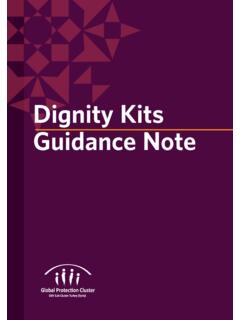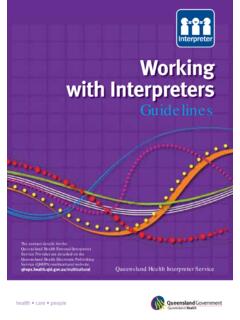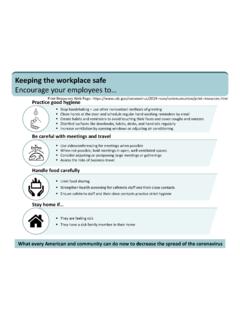Transcription of UNICEF Child Protection Assessment Tool
1 guidelines for Assessments using the UNICEF OLS Child Protection Tool To suggest improvements or amendments to this document, please contact Protection at UNICEF OLS by email phone (+254 020 622423) or in person. 1 Assessment guidelines UNICEF Child Protection Assessment Tool The tool brings together a wide variety of Child Protection Assessment questionnaires into one user-friendly tool. It has been created both to help non- Child Protection people include Child Protection in their assessments, and to help Child Protection people carry out assessments better. 1. WHAT IS Child Protection ? .. 3 2. WHO SHOULD USE THE TOOL? .. 3 3. INCLUDING Child Protection IN ASSESSMENTS .. 4 WHY IS Child Protection Assessment IMPORTANT? .. 4 IMPORTANT PRINCIPLES IN ASSESSMENTS .. 5 4. PREPARATION FOR AN Assessment .
2 5 5. SOME DEFINITIONS .. 7 6. using COMMON SENSE .. 8 7. COMMUNICATION .. 8 8. WHAT TO DO WITH THE INFORMATION GATHERED .. 9 9. WHAT THE TOOL LOOKS LIKE .. 10 DEPTHS WITHIN THE TOOL .. 10 TOPICS WITHIN THE TOOL .. 10 WHO TO ASK (QUESTIONS TO) WITHIN THE TOOL .. 11 SITUATIONS WITHIN THE TOOL .. 11 10. GLOSSARY .. 12 guidelines for Assessments using the UNICEF OLS Child Protection Tool To suggest improvements or amendments to this document, please contact Protection at UNICEF OLS by email phone (+254 020 622423) or in person. 2 These guidelines do not explain how to use the technology ( which buttons to press), which is covered in the Quick Training Session presentation on the CD. If you are using the electronic version of the tool, these guidelines and that presentation complement each other and should be read together.
3 It you are using the paper version, ignore reference to the electronic tool in this document. guidelines for Assessments using the UNICEF OLS Child Protection Tool To suggest improvements or amendments to this document, please contact Protection at UNICEF OLS by email phone (+254 020 622423) or in person. 3 1. What is Child Protection ? The Child focused agencies operating in Sudan have reached an agreed definition of Child Protection : Activities that reduce exposure of children to abuse, neglect and exploitation and that assist them to achieve their basic rights to care, Protection and justice Such Child Protection activities are currently undertaken by a variety of actors in Sudan. An example might be the attempt to put abducted children back in touch with their families and communities, or raise awareness on the health risks of female circumcision.
4 But as the long list of Topics (see below) shows, Child Protection is something that all sectors can contribute to. Many agencies are helping people meet their basic needs in Sudan. Protection , or better, keeping children safe from harm, is something all people in Sudan would like to happen. All actors should be aware of how their activities, including the delivery of basic services, impact on the lives of people, and how their programmes can be used to help reduce vulnerability to exploitation and abuse of children. For example a water engineer who understands that children in some communities are at risk from sexual abuse may realise that the location of latrines can serve to increase that risk or reduce that risk. Another example might be the realisation by food agencies that there are many separated children living in Child headed households within a community.
5 Because they are scared to let adults know that they do not have carers they often fail to get onto registration lists for food distributions. Child Whilst in many cultures across the world the perception of when a girl becomes a woman or when a boy becomes a man varies, under the Convention of Rights of the Child , a Child is every human being below the age of eighteen years . In Sudan all actors have expressed their support for the convention: it has been signed and ratified by the Government of Sudan and forms part of the OLS ground rules signed by the SPLM. 2. Who should use the Tool? The purpose of this tool is to help anyone, whether they have a Child Protection background or not, ask the right questions during assessments. It has been designed with the non-expert in mind, for example a water engineer or a nutritionist doing a needs Assessment can ask about Child Protection issues and pass good basic information on to Child Protection agencies.
6 If you often do assessments, but have never worked on Child Protection , you will find the tool is designed to help you ask questions to the right people, avoiding questions that require in-depth knowledge of Child Protection issues. You can build a precise questionnaire by following simple steps. guidelines for Assessments using the UNICEF OLS Child Protection Tool To suggest improvements or amendments to this document, please contact Protection at UNICEF OLS by email phone (+254 020 622423) or in person. 4 For those with a Child Protection background, you can use the tool to design rapid, intermediate and in-depth questionnaires to help stimulate ideas and structure your interviews. 3. Including Child Protection in Assessments There are two very important reasons that Child Protection should be included in all field assessments in Sudan.
7 Firstly, understanding what is happening to children so that we can find more and better ways of keeping them safe is the responsibility of us all. And secondly, those agencies that have a capacity to respond to Protection needs can only do so if they have information about what is happening to children in each location. As Protection is a very small sector in Sudan it relies on other sectors to help keep it informed. It is hoped that this tool will enable non- Child Protection agencies to include Child Protection in their assessments. It is also hoped that the tool will enhance the assessments already being undertaken by Child Protection agencies. Please read the sections on doing Child focussed components in assessments and communicating with children carefully. Why is Child Protection Assessment important?
8 1 Children and adolescents are frequently among the most vulnerable groups, and without systematic analysis it will not be possible to meet their Protection and assistance needs. Many of these needs are not immediately visible: for example, separated children may be taken in by other families (who may not necessarily be able to provide adequate care and where they are less able to make decisions about their lives), and the needs of adolescents are often relatively invisible. It is easy to make incorrect assumptions about needs and resources if these are not assessed in a systematic manner. Many key Protection issues will not be openly spoken about by the members of the community themselves. For example, the recruitment of Child soldiers, or the exchange of sexual services for food or goods.
9 If Child Protection topics are systematically included in assessments, and concerns raised are passed on to Child Protection agencies, we will gain enough information to understand the causes. By including Child Protection in assessments, non Child Protection agencies can highlight key issues and pass good quality information on to others that are able to respond appropriately. 1 This section, and Important Principles are paraphrased from ARC Action for the Rights of Children a UNHCR/Save the Children publication guidelines for Assessments using the UNICEF OLS Child Protection Tool To suggest improvements or amendments to this document, please contact Protection at UNICEF OLS by email phone (+254 020 622423) or in person.
10 5 Important Principles in Assessments Information-gathering needs to be systematic - the attempt to develop understanding by examining a situation fully and not from a single, personal viewpoint. A mixture of quantitative and qualitative information-gathering is usually required. It is important to avoid making assumptions without carefully checking them out: for example, relying on your own observations may be insufficient. By self-consciously identifying possible sources of bias and error, their effects can be minimized. Information can be cross-checked (sometimes referred to as triangulation) by collecting information in different ways, for example: - By using information from different sources - By using different tools and techniques It is important to guard against the possibility of members of the community giving inaccurate information: for example, in a camp, the fact of an unrelated Child having been taken into the family may be concealed because of fears that his/her ration card might be withheld.












